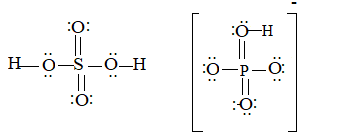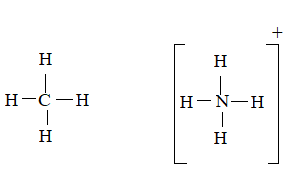
Concept explainers
(a)
Interpretation:
The formula of the polyatomic ion needs to be determinedhaving similar Lewis structure as the
Concept introduction:
The Lewis structures are used to write a shorthand configuration of number of available valence electrons in an atom for bonding. This structure deals with the magic number 8 and hence the octet completion is shown by the bonded electrons between the atoms.
This structure is made on basis of octet rule understanding and it is made sure that the number of electrons surrounding an atom must not divert from the octet.
Answer to Problem 15QAP
Explanation of Solution
Given Information:
The molecule is Cl2.
Here thetotal valence electrons are:
Bond pair electrons are obtained as:
Similarly, lone pairs are counted as:
A similar type of Lewis structure is possible in only such polyatomic ion which has nearly matching electronegativities and same number of valence electrons.
In this pattern, the hypochlorite anion
Here, the valence electrons are:
The bond pair electrons are the number of electrons used in bond formation.
Looking at the structure,
Bond pair electrons are obtained as:
Similarly, lone pairs are counted as:
The Lewis structure will be drawn as:

(b)
Interpretation:
The formula of the polyatomic ion needs to be determined having similar Lewis structure as the
Concept introduction:
The Lewis structures are used to write a shorthand configuration of number of available valence electrons in an atom for bonding. This structure deals with the magic number 8 and hence the octet completion is shown by the bonded electrons between the atoms.
This structure is made on basis of octet rule understanding and it is made sure that the number of electrons surrounding an atom must not divert from the octet.
Answer to Problem 15QAP
Explanation of Solution
Given Information:
The molecule is H2 SO4.
Here the total valence electrons are:
Looking at the structure,
Bond pair electrons are obtained as:
Similarly, lone pairs are counted as:
Now, in this pattern, the anion
Here the valence electrons are:
Looking at the structure,
Bond pair electrons are obtained as:
Similarly, lone pairs are counted as:
The Lewis structure will be drawn as:

(c)
Interpretation:
The formula of the polyatomic ion needs to be determined having similar Lewis structure as the
Concept introduction:
The Lewis structures are used to write a shorthand configuration of number of available valence electrons in an atom for bonding. This structure deals with the magic number 8 and hence the octet completion is shown by the bonded electrons between the atoms.
This structure is made on basis of octet rule understanding and it is made sure that the number of electrons surrounding an atom must not divert from the octet.
Answer to Problem 15QAP
Explanation of Solution
Given Information:
The molecule is CH4.
Here the total valence electrons are:
Bond pair electrons are obtained as:
Similarly, lone pairs are counted as:
A similar type of Lewis structure is possible in only such polyatomic ion, which has nearly matching electronegativities and same number of valence electrons.
In this pattern, the ammonium ion
Here, the valence electrons are:
Bond pair electrons are obtained as:
Similarly, lone pairs are counted as:
The Lewis structure will be drawn as:

(d)
Interpretation:
The formula of the polyatomic ion needs to be determined having similar Lewis structure as the
Concept introduction:
The Lewis structures are used to write a shorthand configuration of number of available valence electrons in an atom for bonding. This structure deals with the magic number 8 and hence the octet completion is shown by the bonded electrons between the atoms.
This structure is made on basis of octet rule understanding and it is made sure that the number of electrons surrounding an atom must not divert from the octet.
Answer to Problem 15QAP
Explanation of Solution
Given Information:
The molecule is GeCl4.
Here the total valence electrons are:
Bond pair electrons are obtained as:
Similarly, lone pairs are counted as:
A similar type of Lewis structure is possible in only such polyatomic ion, which has nearly matching electro negativities and same number of valance electrons.
In this pattern, the ion
Here, the valence electrons are:
Bond pair electrons are obtained as:
Similarly, lone pairs are counted as:
The Lewis structure will be drawn as:

Want to see more full solutions like this?
Chapter 7 Solutions
Chemistry: Principles and Reactions
- Identify the electron pair geometry, the molecular structure of each, and the polarity of the following molecules: (a) ClNO (N is the central atom) (b) Cl2CO (C is the central atom) (c) Cl2SO (S is the central atom) (d) SO2F2 (S is the central atom) (e) XeO2F2 (Xe is the central atom) (f) ClOF2 + (Cl is the central atom)arrow_forwardCyanogen (CN)2 is known as pseodohalogen because it has some properties like halogens. It is composed of two CN’s joined together.(i) Draw the Lewis structure for all the possible combination for (CN)2.(ii) Calculate the formal charge and determine which one of the structures that you have drawn is most stable.(iii) For the stable structure, determine the geometry around the two central atoms.(iv) For the stable structure, draw the dipole arrows for the bonds.(v) Base on the stable structure, determine the polarity of molecule and state your reason.arrow_forwardDraw a Lewis structure for each of the following molecules: (a) chlorodifluoromethane, CHClF2 (b) propanoic acid, C2 H5CO2H (basic structure pictured below) (c) acetonitrile, CH3CH (the framework is H3C-C-N) (d) allene, H3CCCH2arrow_forward
- (i) What is a chemical bond? . (ii) List and locate the different types of bonds that hold particles together in NH4CI (s)arrow_forwardWrite Lewis formulas, including unshared pairs, for each of the following. Carbon has four bonds in each compound. (a) Propane (C3H8) (c) Methyl fluoride (CH3F) (b) Methanol (CH4O) (d) Ethyl fluoride (C2H5F)arrow_forwardHow many nonbonding pairs (or lone-pairs) of electrons are found on the central atom in the Lewis structure of XeF2 molecule? (A) 0 (B) 1 (C) 2 (D) 3arrow_forward
- Consider the following compounds: BeCl 2 , MgBr 2 , and SrBr 2 . Answer the following questions based on expected periodic trends: (a) Which is expected to have the shortest ionic bonds? (b) Which is expected to have the highest lattice energy? (c) Which is expected to have the lowest melting point?arrow_forward(a) Complete the Lewis structure for vinyl chloride by showing all unshared pairs of electrons. (b) Predict the H-C-H, H-C-C, and Cl-C-H bond angles in this molecule. (c) Does vinyl chloride have polar bonds? Is it a polar molecule? Does it have a dipole?arrow_forwardWhich of the following is a resonance structure of compound X? N (A) OH NH (B) X NH O NH (C) N (D)arrow_forward
- Which statements are true about electronegativity? (a) Electronegativity increases from left to right in a period of the Periodic Table. (b) Electronegativity increases from top to bottom in a column of the Periodic Table . (c) Hydrogen, the element with the lowest atomic number, has the smallest electronegativity. (d) The higher the atomic number of an element, the greater its electronegativity.arrow_forwardDraw Lewis structures for the following molecules and ion. (c) H2O2 (a) NCl3 (b) OCS (d) HCOO−arrow_forwardA resident expert on electronegativity comes up to visit with you. He makes two claims (seen below) about electronegativity with relation to covalent bonding. Is the expert correct or can you refute him with your knowledge of electronegativity? (a) If a diatomic molecule is made up of atoms X and Y, which have different electronegativities, the molecule must be polar. (b) The farther two atoms are apart in a bond, the larger the dipole moment will be.arrow_forward
 ChemistryChemistryISBN:9781305957404Author:Steven S. Zumdahl, Susan A. Zumdahl, Donald J. DeCostePublisher:Cengage Learning
ChemistryChemistryISBN:9781305957404Author:Steven S. Zumdahl, Susan A. Zumdahl, Donald J. DeCostePublisher:Cengage Learning ChemistryChemistryISBN:9781259911156Author:Raymond Chang Dr., Jason Overby ProfessorPublisher:McGraw-Hill Education
ChemistryChemistryISBN:9781259911156Author:Raymond Chang Dr., Jason Overby ProfessorPublisher:McGraw-Hill Education Principles of Instrumental AnalysisChemistryISBN:9781305577213Author:Douglas A. Skoog, F. James Holler, Stanley R. CrouchPublisher:Cengage Learning
Principles of Instrumental AnalysisChemistryISBN:9781305577213Author:Douglas A. Skoog, F. James Holler, Stanley R. CrouchPublisher:Cengage Learning Organic ChemistryChemistryISBN:9780078021558Author:Janice Gorzynski Smith Dr.Publisher:McGraw-Hill Education
Organic ChemistryChemistryISBN:9780078021558Author:Janice Gorzynski Smith Dr.Publisher:McGraw-Hill Education Chemistry: Principles and ReactionsChemistryISBN:9781305079373Author:William L. Masterton, Cecile N. HurleyPublisher:Cengage Learning
Chemistry: Principles and ReactionsChemistryISBN:9781305079373Author:William L. Masterton, Cecile N. HurleyPublisher:Cengage Learning Elementary Principles of Chemical Processes, Bind...ChemistryISBN:9781118431221Author:Richard M. Felder, Ronald W. Rousseau, Lisa G. BullardPublisher:WILEY
Elementary Principles of Chemical Processes, Bind...ChemistryISBN:9781118431221Author:Richard M. Felder, Ronald W. Rousseau, Lisa G. BullardPublisher:WILEY





